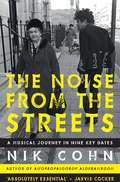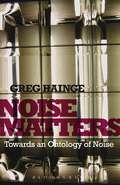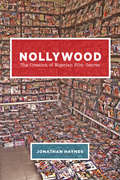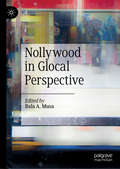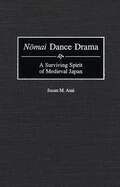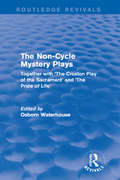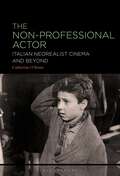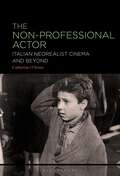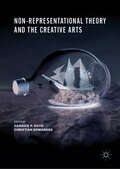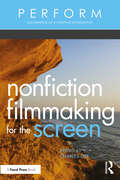- Table View
- List View
The Noise from the Streets: A musical journey in nine key dates
by Nik CohnNik Cohn is a rock legend and music journalist - a Derry boy who became the omnipresent man in music's developing story from the 50s to the present; a self-styled rat, addicted to adventure, forever at the heart of the real action. This short memoir provides a strong flavour of the person whose writing inspired Saturday Night Fever and several other pop-culture landmarks. Cohn leads us, in reverse order, through the decades of his musical life and times. Along the way, we meet familiar heroes and rogues - let readers decide the categories to which Jimi Hendrix, Keith Moon, PJ Proby, Sid Vicious et al belong. The Noise From The Streets is elegiac, charming and thoughtful - wallow in it. Nik Cohn recently topped Jarvis Cocker's top 10 music books in The Guardian (13 June 2014) for his title Awopbopaloobop Alopbamboom. 'The original title for this book was 'Pop from the Beginning' and that pretty much sums it up. Nik Cohn was only just out of his teens when he wrote it and it's the book to read if you want to get some idea of the original primal energy of pop music. Loads of unfounded, biased assertions that almost always turn out to be right. He went on to provide the inspiration for Saturday Night Fever (Hurrah!) and Tommy (Boo!), but this is still his best book. Absolutely essential.'
Noise Matters: Towards an Ontology of Noise
by Greg HaingeEveryone knows what noise is. Or do they? Can we in fact say that one man's noise is another teenager's music? Is noise in fact only an auditory phenomenon or does it extend far beyond this realm? If our common definitions of noise are necessarily subjective and noise is not just unpleasant sound, then it merits a closer look (or listen). Greg Hainge sets out to define noise in this way, to find within it a series of operations common across its multiple manifestations that allow us to apprehend it as something other than a highly subjective term that tells us very little. Examining a wide range of texts, including Sartre's novel Nausea and David Lynch's iconic films Eraserhead and Inland Empire, Hainge investigates some of the Twentieth Century's most infamous noisemongers to suggest that they're not that noisy after all; and it finds true noise in some surprising places. The result is a thrilling and illuminating study of sound and culture.
Noise Matters: Towards an Ontology of Noise
by Greg HaingeEveryone knows what noise is. Or do they? Can we in fact say that one man's noise is another teenager's music? Is noise in fact only an auditory phenomenon or does it extend far beyond this realm? If our common definitions of noise are necessarily subjective and noise is not just unpleasant sound, then it merits a closer look (or listen). Greg Hainge sets out to define noise in this way, to find within it a series of operations common across its multiple manifestations that allow us to apprehend it as something other than a highly subjective term that tells us very little. Examining a wide range of texts, including Sartre's novel Nausea and David Lynch's iconic films Eraserhead and Inland Empire, Hainge investigates some of the Twentieth Century's most infamous noisemongers to suggest that they're not that noisy after all; and it finds true noise in some surprising places. The result is a thrilling and illuminating study of sound and culture.
The Nolan Variations: Free Ebook Sampler
by Tom ShoneFree ebook sampler.The Nolan Variations is a rare, intimate portrait of Christopher Nolan, one of the most profound and commercially successful directors at work today. In this in-depth exploration of his work - including The Dark Knight (2008), Inception (2010) and Dunkirk (2017) - Nolan discusses the evolution of his pictures; his thoughts on time, identity, perception, chaos, and daydreams. The book has been done with the full cooperation of Nolan, who has opened himself up more fully than ever before in his talks with Tom Shone.
The Nolan Variations: The Movies, Mysteries, and Marvels of Christopher Nolan
by Tom ShoneA rare, intimate portrait of Hollywood's reigning 'blockbuster auteur' whose deeply personal billion-dollar movies have established him as the most successful director to come out of the British Isles since Alfred Hitchcock. 'A masterclass . . . brilliant. Immersive, detailed, meticulous, privileged inside-dope.' - Craig Raine More than just the tinkerings of a glass watchmaker, Christopher Nolan's films have an unerring grasp of the way time makes us feel. Time steals people away in his films, and he takes careful note of the theft. Time is Nolan's great antagonist, his lifelong nemesis. He seems almost to take it personally.Written with the full cooperation of Nolan himself, who granted Tom Shone access to never-before-seen photographs, storyboards and sketches, the book is a deep-dive into the director's films, influences, methods and obsessions. Here for the first time is Nolan on his dislocated, transatlantic childhood, how he dreamed up the plot of Inception lying awake one night in his dorm at school, his colour-blindness and its effect on Memento, his obsession with puzzles and optical illusions - and much, much more. Written by one of our most penetrating critics, The Nolan Variations is a landmark study of one of the twenty-first century's most dazzling cinematic artists.'Christopher Nolan is a wonderfully unlikely contemporary filmmaker. We're fortunate indeed to have him, and fortunate now to have this book.' - William Gibson
Nollywood: The Creation of Nigerian Film Genres
by Jonathan HaynesNigeria’s Nollywood has rapidly grown into one of the world’s largest film industries, radically altering media environments across Africa and in the diaspora; it has also become one of African culture’s most powerful and consequential expressions, powerfully shaping how Africans see themselves and are seen by others. With this book, Jonathan Haynes provides an accessible and authoritative introduction to this vast industry and its film culture. Haynes describes the major Nigerian film genres and how they relate to Nigerian society—its values, desires, anxieties, and social tensions—as the country and its movies have developed together over the turbulent past two decades. As he shows, Nollywood is a form of popular culture; it produces a flood of stories, repeating the ones that mean the most to its broad audience. He interprets these generic stories and the cast of mythic figures within them: the long-suffering wives, the business tricksters, the Bible-wielding pastors, the kings in their traditional regalia, the glamorous young professionals, the emigrants stranded in New York or London, and all the rest. Based on more than twenty years of research, Haynes’s survey of Nollywood’s history and genres is unprecedented in scope, while his book also vividly describes landmark films, leading directors, and the complex character of this major branch of world cinema.
Nollywood: The Creation of Nigerian Film Genres
by Jonathan HaynesNigeria’s Nollywood has rapidly grown into one of the world’s largest film industries, radically altering media environments across Africa and in the diaspora; it has also become one of African culture’s most powerful and consequential expressions, powerfully shaping how Africans see themselves and are seen by others. With this book, Jonathan Haynes provides an accessible and authoritative introduction to this vast industry and its film culture. Haynes describes the major Nigerian film genres and how they relate to Nigerian society—its values, desires, anxieties, and social tensions—as the country and its movies have developed together over the turbulent past two decades. As he shows, Nollywood is a form of popular culture; it produces a flood of stories, repeating the ones that mean the most to its broad audience. He interprets these generic stories and the cast of mythic figures within them: the long-suffering wives, the business tricksters, the Bible-wielding pastors, the kings in their traditional regalia, the glamorous young professionals, the emigrants stranded in New York or London, and all the rest. Based on more than twenty years of research, Haynes’s survey of Nollywood’s history and genres is unprecedented in scope, while his book also vividly describes landmark films, leading directors, and the complex character of this major branch of world cinema.
Nollywood: The Creation of Nigerian Film Genres
by Jonathan HaynesNigeria’s Nollywood has rapidly grown into one of the world’s largest film industries, radically altering media environments across Africa and in the diaspora; it has also become one of African culture’s most powerful and consequential expressions, powerfully shaping how Africans see themselves and are seen by others. With this book, Jonathan Haynes provides an accessible and authoritative introduction to this vast industry and its film culture. Haynes describes the major Nigerian film genres and how they relate to Nigerian society—its values, desires, anxieties, and social tensions—as the country and its movies have developed together over the turbulent past two decades. As he shows, Nollywood is a form of popular culture; it produces a flood of stories, repeating the ones that mean the most to its broad audience. He interprets these generic stories and the cast of mythic figures within them: the long-suffering wives, the business tricksters, the Bible-wielding pastors, the kings in their traditional regalia, the glamorous young professionals, the emigrants stranded in New York or London, and all the rest. Based on more than twenty years of research, Haynes’s survey of Nollywood’s history and genres is unprecedented in scope, while his book also vividly describes landmark films, leading directors, and the complex character of this major branch of world cinema.
Nollywood: The Creation of Nigerian Film Genres
by Jonathan HaynesNigeria’s Nollywood has rapidly grown into one of the world’s largest film industries, radically altering media environments across Africa and in the diaspora; it has also become one of African culture’s most powerful and consequential expressions, powerfully shaping how Africans see themselves and are seen by others. With this book, Jonathan Haynes provides an accessible and authoritative introduction to this vast industry and its film culture. Haynes describes the major Nigerian film genres and how they relate to Nigerian society—its values, desires, anxieties, and social tensions—as the country and its movies have developed together over the turbulent past two decades. As he shows, Nollywood is a form of popular culture; it produces a flood of stories, repeating the ones that mean the most to its broad audience. He interprets these generic stories and the cast of mythic figures within them: the long-suffering wives, the business tricksters, the Bible-wielding pastors, the kings in their traditional regalia, the glamorous young professionals, the emigrants stranded in New York or London, and all the rest. Based on more than twenty years of research, Haynes’s survey of Nollywood’s history and genres is unprecedented in scope, while his book also vividly describes landmark films, leading directors, and the complex character of this major branch of world cinema.
Nollywood: The Creation of Nigerian Film Genres
by Jonathan HaynesNigeria’s Nollywood has rapidly grown into one of the world’s largest film industries, radically altering media environments across Africa and in the diaspora; it has also become one of African culture’s most powerful and consequential expressions, powerfully shaping how Africans see themselves and are seen by others. With this book, Jonathan Haynes provides an accessible and authoritative introduction to this vast industry and its film culture. Haynes describes the major Nigerian film genres and how they relate to Nigerian society—its values, desires, anxieties, and social tensions—as the country and its movies have developed together over the turbulent past two decades. As he shows, Nollywood is a form of popular culture; it produces a flood of stories, repeating the ones that mean the most to its broad audience. He interprets these generic stories and the cast of mythic figures within them: the long-suffering wives, the business tricksters, the Bible-wielding pastors, the kings in their traditional regalia, the glamorous young professionals, the emigrants stranded in New York or London, and all the rest. Based on more than twenty years of research, Haynes’s survey of Nollywood’s history and genres is unprecedented in scope, while his book also vividly describes landmark films, leading directors, and the complex character of this major branch of world cinema.
Nollywood: The Creation of Nigerian Film Genres
by Jonathan HaynesNigeria’s Nollywood has rapidly grown into one of the world’s largest film industries, radically altering media environments across Africa and in the diaspora; it has also become one of African culture’s most powerful and consequential expressions, powerfully shaping how Africans see themselves and are seen by others. With this book, Jonathan Haynes provides an accessible and authoritative introduction to this vast industry and its film culture. Haynes describes the major Nigerian film genres and how they relate to Nigerian society—its values, desires, anxieties, and social tensions—as the country and its movies have developed together over the turbulent past two decades. As he shows, Nollywood is a form of popular culture; it produces a flood of stories, repeating the ones that mean the most to its broad audience. He interprets these generic stories and the cast of mythic figures within them: the long-suffering wives, the business tricksters, the Bible-wielding pastors, the kings in their traditional regalia, the glamorous young professionals, the emigrants stranded in New York or London, and all the rest. Based on more than twenty years of research, Haynes’s survey of Nollywood’s history and genres is unprecedented in scope, while his book also vividly describes landmark films, leading directors, and the complex character of this major branch of world cinema.
Nollywood Central: The Nigerian Videofilm Industry (International Screen Industries)
by Jade L. MillerNollywood is often portrayed by the popular press as an unruly industry, with mysteriously fast and cheap production and shadowy distribution networks. In the first overview of Nigeria's burgeoning video film industry, Jade L. Miller reveals that this portrayal is over-simplistic and often untrue. Investigating Nollywood's complete global production and distribution chain, Nollywood Central presents a full portrait of the Nollywood industry as both highly organised and strategically structured. In doing so, it interrogates the position and rise of new cultural industry hubs, demonstrating how a creative industry can emerge, be sustainable and circulate globally even though it exists outside of formal global networks and government-supported infrastructure. Deepening understanding of this prolific industry while at the same time contributing to debates surrounding global flows of culture, this is a critical resource for students and scholars of Media and Communication Studies, Film Studies, Television Studies and African Studies.
Nollywood in Glocal Perspective
by Bala A. MusaThis book gives a panoramic view of the rise and growth of Nollywood, Nigeria’s movie and home video entertainment industry, into the second largest and most prolific movie-producing industry in the world. It offers an analysis of Nollywood’s influence as a local and global cultural force. Scholars from Africa, the African Diaspora and beyond examine the factors that have shaped Nollywood’s unique story-telling, production, and distribution system. The volume shows how internal and external economic, social, cultural and technological changes intersect to define Nollywood’s film-making and entertainment ethos. It is grounded in sound theoretical perspectives that help readers understand the texts and subtexts of the industry’s emergence, transformation, and impact. The range of subjects covered span Nollywood’s historical roots in Nigeria pre-colonial traveling/community theatre to colonial era film-making, and its contemporary spin-offs and inspired cousins across Africa and in Europe. It illuminates the interface of artistic, business, cultural and technological innovation and creativity at the heart of Africa’s local and global pop culture explosion.
Nomai Dance Drama: A Surviving Spirit of Medieval Japan (Contributions to the Study of Music and Dance)
by Susan M. AsaiNomai dance drama, an artistic expression combining sacred, communal, economic, and cultural spheres of community life in the district of Higashidorimura, is a performing tradition that provides an identity to agriculturally based villages. It has retained features characteristic of the music, drama, and sacred practices of medieval Japan. N=omai singing exhibits traits linked to Buddhist chanting. The instrumental music originates from folk Shinto. This study highlights the social and cultural value n=omaii has for the residents in villages that perform it by providing the historical context in which it is examined, as well as its current performance practices.As this work explores the aspects of agricultural Japanese society, revealed through a dance drama, it will appeal to music and drama scholars as well as students of Japanese culture and history. After establishing the historical lens from which to view n^D=omai drama, the theatrical and musical aspects are discussed in detail. Photographs and musical examples enhance this thorough, well-organized study.
Non-Cinema: Global Digital Film-making and the Multitude (Thinking Cinema)
by William BrownNon-Cinema: Global Digital Film-making and the Multitude provides an original film-philosophy through which to understand low budget digital filmmaking from around the globe. It draws upon a wide range of western and non-western philosophers, physicists, theorists of 'Third Cinema,' and contemporary film theorists and film-philosophers in order to argue that the future of cinema lies at the margins, in the extreme, the overlooked and the under-funded – the sort that distributors, exhibitors and audiences would not consider to be cinema at all, hence "non-cinema." Analysing numerous films, William Brown argues that contemporary low-budget digital cinema is also through its digital form a political cinema that suggests that we are not detached observers of the world, but entangled participants therewith. Non-Cinema constructs this argument by looking at work by established filmmakers like Jean-Luc Godard, Abbas Kiarostami, Jafar Panahi and Michael Winterbottom, as well as lesser known work from places as diverse as Asia, the Middle East, Europe, the Americas and Africa.
Non-Cinema: Global Digital Film-making and the Multitude (Thinking Cinema)
by William BrownNon-Cinema: Global Digital Film-making and the Multitude provides an original film-philosophy through which to understand low budget digital filmmaking from around the globe. It draws upon a wide range of western and non-western philosophers, physicists, theorists of 'Third Cinema,' and contemporary film theorists and film-philosophers in order to argue that the future of cinema lies at the margins, in the extreme, the overlooked and the under-funded – the sort that distributors, exhibitors and audiences would not consider to be cinema at all, hence "non-cinema." Analysing numerous films, William Brown argues that contemporary low-budget digital cinema is also through its digital form a political cinema that suggests that we are not detached observers of the world, but entangled participants therewith. Non-Cinema constructs this argument by looking at work by established filmmakers like Jean-Luc Godard, Abbas Kiarostami, Jafar Panahi and Michael Winterbottom, as well as lesser known work from places as diverse as Asia, the Middle East, Europe, the Americas and Africa.
The Non-Cycle Mystery Plays: Together with 'The Croxton Play of the Sacrament' and 'The Pride of Life' (Routledge Revivals)
by Osborn WaterhouseBetween the beginning of the tenth and the end of the sixteenth centuries, in all parts of Great Britain from Aberdeen to Cornwall, performances of liturgical and mystery plays are on record. This book, first published in 1909, is a collection of early-English religious plays with a detailed introduction written by the editor Osborn Waterhouse. The Non-Cycle Mystery Plays will be of interest to students of drama, performance and theatre studies.
The Non-Cycle Mystery Plays: Together with 'The Croxton Play of the Sacrament' and 'The Pride of Life' (Routledge Revivals)
by Osborn WaterhouseBetween the beginning of the tenth and the end of the sixteenth centuries, in all parts of Great Britain from Aberdeen to Cornwall, performances of liturgical and mystery plays are on record. This book, first published in 1909, is a collection of early-English religious plays with a detailed introduction written by the editor Osborn Waterhouse. The Non-Cycle Mystery Plays will be of interest to students of drama, performance and theatre studies.
The Non-Professional Actor: Italian Neorealist Cinema and Beyond
by Dr. Catherine O'RaweProvides the first critical overview of acting, stardom, and performance in post-war Italian film (1945-54), with special attention to the figure of the non-professional actor, who looms large in neorealist filmmaking. Italian post-war cinema has been widely celebrated by critics and scholars: films such as Bicycle Thieves (De Sica, 1948) and Paisan (Rossellini, 1946) remain globally influential, particularly for their use of non-professional actors. This period of regeneration of Italian cinema initiated the boom in cinemagoing that made cinema an important vector of national and gender identity for audiences.The book addresses the casting, performance, and labour of non-professional actors, particularly children, their cultural and economic value to cinema, and how their use brought ideas of the ordinary into the discourse of stars as extraordinary. Relatedly, O'Rawe discusses critical and press discourses around acting, performance, and stardom, often focused on the 'crisis' of acting connected to the rise of non-professionals and the girls (like Sophia Loren) who found sudden cinematic fame via beauty contests.
The Non-Professional Actor: Italian Neorealist Cinema and Beyond
by Dr. Catherine O'RaweProvides the first critical overview of acting, stardom, and performance in post-war Italian film (1945-54), with special attention to the figure of the non-professional actor, who looms large in neorealist filmmaking. Italian post-war cinema has been widely celebrated by critics and scholars: films such as Bicycle Thieves (De Sica, 1948) and Paisan (Rossellini, 1946) remain globally influential, particularly for their use of non-professional actors. This period of regeneration of Italian cinema initiated the boom in cinemagoing that made cinema an important vector of national and gender identity for audiences.The book addresses the casting, performance, and labour of non-professional actors, particularly children, their cultural and economic value to cinema, and how their use brought ideas of the ordinary into the discourse of stars as extraordinary. Relatedly, O'Rawe discusses critical and press discourses around acting, performance, and stardom, often focused on the 'crisis' of acting connected to the rise of non-professionals and the girls (like Sophia Loren) who found sudden cinematic fame via beauty contests.
Non-Representational Theory and the Creative Arts
by Candice P. Boyd Christian EdwardesThis book presents distinct perspectives from both geographically-oriented creative practices and geographers working with arts-based processes. In doing so, it fills a significant gap in the already sizeable body of non-representational discourse by bringing together images and reflections on performances, art practice, theatre, dance, and sound production alongside theoretical contributions and examples of creative writing. It considers how contemporary art making is being shaped by spatial enquiry and how geographical research has been influenced by artistic practice. It provides a clear and concise overview of the principles of non-representational theory for researchers and practitioners in the creative arts and, across its four sections, demonstrates the potential for non-representational theory to bring cultural geography and contemporary art closer than ever before.
Nonfiction Filmmaking for the Screen (PERFORM)
by Charles DyeCombining essays and interviews with nonfiction filmmakers, this collection explores the business side of nonfiction media creation for film and television. Over 30 industry professionals dispel myths about the industry and provide practical advice on topics such as how to break into the field; how to develop, nurture, and navigate business relationships; and how to do creative work under pressure. Readers will also learn about the entrepreneurial expectations in relation to marketing, strategies for contending with the emotional highs and lows of creating nonfiction media, and money management whilst pursuing a career in creating nonfiction media. Written for undergraduates and graduates studying filmmaking, media production, and documentary filmmaking, as well as aspiring nonfiction media creators and documentary filmmakers, this book provides readers with a wealth of first-hand information that will help them create their own opportunities and pursue a career in nonfiction film and television.
Nonfiction Filmmaking for the Screen (PERFORM)
Combining essays and interviews with nonfiction filmmakers, this collection explores the business side of nonfiction media creation for film and television. Over 30 industry professionals dispel myths about the industry and provide practical advice on topics such as how to break into the field; how to develop, nurture, and navigate business relationships; and how to do creative work under pressure. Readers will also learn about the entrepreneurial expectations in relation to marketing, strategies for contending with the emotional highs and lows of creating nonfiction media, and money management whilst pursuing a career in creating nonfiction media. Written for undergraduates and graduates studying filmmaking, media production, and documentary filmmaking, as well as aspiring nonfiction media creators and documentary filmmakers, this book provides readers with a wealth of first-hand information that will help them create their own opportunities and pursue a career in nonfiction film and television.
Nonfiction Sound and Story for Film and Video: A Practical Guide for Filmmakers and Digital Content Creators (The Producer's Playbook)
by Amy DeLouise Cheryl OttenritterThis book guides nonfiction storytellers in the art of creatively and strategically using sound to engage their audience and bring stories to life. Sound is half of film and video storytelling, and yet its importance is often overlooked until a post-production emergency arises. Written by two experienced creators—one a seasoned nonfiction producer/director with a background in music, and one a sound designer who owns a well-regarded mix studio—this book teaches nonfiction producers, filmmakers, and branded content creators how to reimagine their storytelling by improving sound workflow from field to post. In addition to real-world examples from the authors’ own experiences, interviews with and examples from industry professionals across many genres of nonfiction production are included throughout. Written in a conversational style, the book pinpoints practical topics and considerations like 360 video and viewer accessibility. As such, it is a vital point of reference for all nonfiction filmmakers, directors, and producers, or anyone wanting to learn how to improve their storytelling. An accompanying Companion Website offers listening exercises, production sound layout diagrams, templates, and other resources.
Nonfiction Sound and Story for Film and Video: A Practical Guide for Filmmakers and Digital Content Creators (The Producer's Playbook)
by Amy DeLouise Cheryl OttenritterThis book guides nonfiction storytellers in the art of creatively and strategically using sound to engage their audience and bring stories to life. Sound is half of film and video storytelling, and yet its importance is often overlooked until a post-production emergency arises. Written by two experienced creators—one a seasoned nonfiction producer/director with a background in music, and one a sound designer who owns a well-regarded mix studio—this book teaches nonfiction producers, filmmakers, and branded content creators how to reimagine their storytelling by improving sound workflow from field to post. In addition to real-world examples from the authors’ own experiences, interviews with and examples from industry professionals across many genres of nonfiction production are included throughout. Written in a conversational style, the book pinpoints practical topics and considerations like 360 video and viewer accessibility. As such, it is a vital point of reference for all nonfiction filmmakers, directors, and producers, or anyone wanting to learn how to improve their storytelling. An accompanying Companion Website offers listening exercises, production sound layout diagrams, templates, and other resources.
